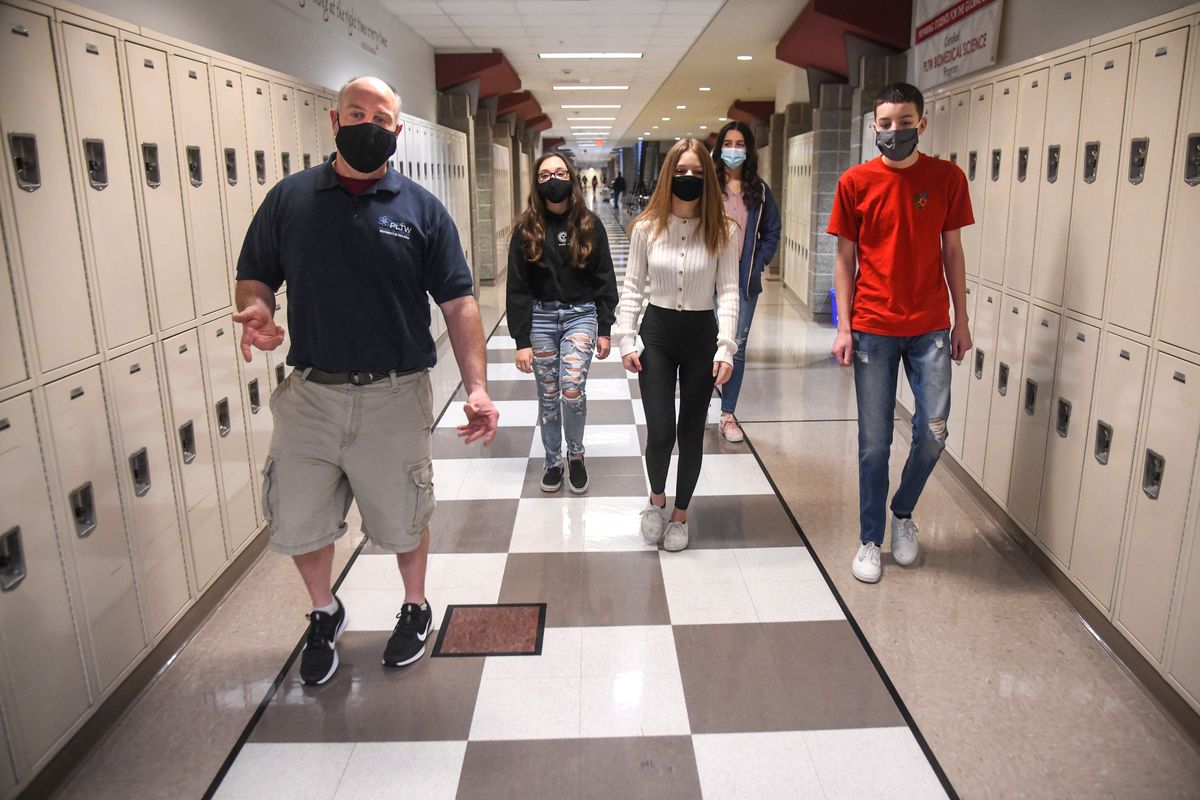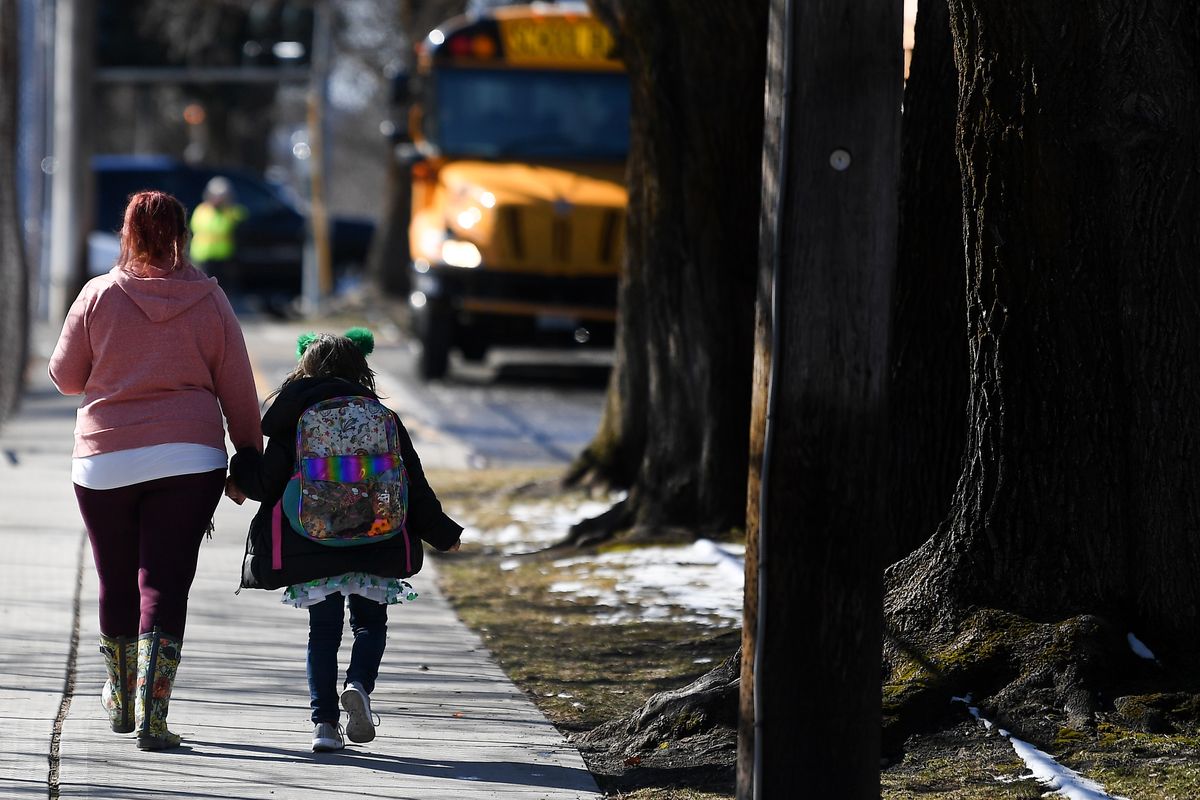As kids head back for full-time in-person instruction, experts urge masks, vaccines as COVID-19 risk remains high
University High School biomed teacher Joe McCollum, left, leads his freshman students out of his classroom and down the school halls for a tour on the first day of in-person learning, Feb. 1 in Spokane Valley. (DAN PELLE/THE SPOKESMAN-REVIEW)Buy a print of this photo
OLYMPIA – A year ago, few students prepared for an in-person first day of school.
During the course of the school year, vaccines became more readily available and evidence showed in-person learning was not a risk to most, setting the state up for a completely in-person school year this fall.
Washington students are now preparing for a school year back in person five days a week, expected by the Office of the Superintendent of Public Instruction and Gov. Jay Inslee’s office. But as the highly contagious delta variant causes outbreaks across the country and as the vaccine is not yet available for kids under 12, the COVID-19 risk in schools remains high.
After more than a year of online learning, experts, health officials, parents and teachers can all agree: kids need to be back in school.
“Without additional measures, keeping schools open will be a challenge,” Superintendent of Public Instruction Chris Reykdal told reporters Friday.
COVID-19 risk remains high this year
The biggest change between this year and last year is the availability of the vaccine, Alex Perkins, associate professor of biological sciences at Notre Dame, said. Many teachers have now been vaccinated, but that’s not the whole story.
With low vaccination rates among students under 18 and no vaccine availability for those under 12, “nothing has really changed,” said Perkins, who has modeled infectious disease transmission in schools.
“Kids are facing a very risky situation going back to schools,” Perkins said.
The delta variant has changed the game slightly, Perkins said, making transmission easier, even among kids. Large groups of students in one place, like in a lunch room or gym, present more opportunities for more kids to get infected.
When modeling for last school year, Perkins said he found many schools still had lower than normal in-person enrollment, but he anticipates more students will be returning in person this fall.
Perkins said he expects outbreaks nationwide when schools reopen with risk likely higher in areas of higher community transmission. All of Washington’s counties have either high or substantial COVID-19 transmission, according to the Centers for Disease Control and Prevention.
“Schools are going to be a hub for transmission in communities because of how intertwined with communities and the very high levels of susceptibility within schools,” Perkins said.
When outbreaks occur, students and staff are forced to quarantine, which can be disruptive, Perkins said.
Dr. Michael Barsotti, who is the chief administrative officer at Sacred Heart Children’s Hospital, said he is starting to see more children come into the hospital because of COVID-19. In January, Barsotti said kids would come into the hospital for something else and then test positive for COVID-19.
“They’re sicker than they were in January,” said Barsotti, president of the Washington Chapter of the American Academy of Pediatrics.
As of Thursday, Sacred Heart had four adolescents, including two in the pediatrics intensive care unit, hospitalized. Although those numbers aren’t huge, he said he would anticipate them going up as cases rise and kids head back into school.
The fall and the winter also bring other transmissible diseases, such as the flu or respiratory syncytial virus. Both of which have overlapping symptoms with COVID-19.
“We are anticipating we’re going to have a very tough fall and winter for hospitalizations for pediatrics,” Barsotti said.
However, health officials and experts agree children need to be back in school despite the risk, as a year and a half of online learning has affected students mental and physical health as well as their performance in school.
“Going back to school is hugely important,” Barsotti said.
So, he added, the question is how to do that safely.
Vaccines ‘most effective’ in minimizing risk but rates still low
The most effective way to protect from COVID-19 is getting a vaccine, Barsotti said. Vaccines, however, are not readily available for most students.
Children under 12 are not yet eligible for a COVID-19 vaccine, and officials and experts have said it likely won’t be available to kids until winter or early next year.
Children between 12 and 18 are eligible for the Pfizer-BioNTech vaccine, but youth vaccination rates are still low. According to the Department of Health, only about 46% of 16- and 17-year-olds and 37% of 12- to 15-year-olds are fully vaccinated against COVID-19. In Spokane, those numbers are even lower, with only 26% of those between 12 and 17 fully vaccinated.
“That leaves a large, large number of school-aged kids that are unvaccinated,” Barsotti said.
The primary reason kids aren’t vaccinated yet comes down to their parents, who have to give permission in most cases before a child can receive a vaccine in Washington.
A small group of parents may never be swayed to vaccinate their children, Barsotti said, but there are other groups who are hesitant because they are relying on misinformation or may be waiting for full FDA approval, likely to come in the coming weeks.
Because vaccinations aren’t available for all students, many are looking to teachers to get their dose.
Reykdal sent a letter to Gov. Jay Inslee on Thursday urging him to require all employees in public K-12 schools to get vaccinations as a condition of employment. Reykdal said there would be exemptions for those who could not get vaccinated for medical or religious reasons.
The mandate would not apply to students, he said, but getting teachers vaccinated is the best chance at keeping schools open this fall.
“We have to create a bigger buffer than what we have today,” he said.
More vaccinations in students and teachers is always going to be helpful, Perkins said. Although breakthrough cases are possible among those vaccinated, it’s still beneficial to decrease the severity of outbreaks.
Masks second best at slowing spread and most students support them
With such low rates, vaccines are not going to do the trick themselves, Perkins said, but requiring masks is “a great starting point.”
Masking is the second most effective thing to slow the spread, behind vaccinations, Barsotti said.
A study in North Carolina showed that wearing masks is an effective way to prevent COVID-19 transmission in schools. The study, done by the ABC Science Collective at Duke University, found returning to full in-person instruction was safe when masking is in place.
“Proper masking is the most effective mitigation strategy to prevent secondary transmission in schools when COVID-19 is circulating and when vaccination is unavailable, or there is insufficient uptake,” the report read.
Researchers looked at 100 school districts operating in person with masking and minimal physical distancing from March through June 2021. During that time, out of the more than 1,280,000 students and 160,000 staff members only one in 3,000 students who were in school buildings became infected.
In Washington, masks are required in all K-12 buildings, regardless of vaccination status, according to OSPI guidlines.
Mead High School junior Margo Moore said the mask mandate in schools is a good thing.
“It really sucks wearing them, but I believe students and teachers need to step up and wear them,” she said.
On the other hand, Maisie Criswell, an incoming senior at Shadle Park High School, said the mask mandate in schools should be the same as in public.
“Those who are vaccinated should also not be forced to wear a mask,” she said. She added that although the delta variant is intimidating “we should be able to do what we think is best for ourselves.”
According to the Centers for Disease Control and Prevention, multiple studies have shown that “consistently implemented layered prevention strategies have shown success in limiting transmission in schools.”
The CDC is recommending mask use for all teachers, staff and students ages two and up inside K-12 buildings. Generally, most people do not need to wear masks outdoors, the CDC says.
The American Academy of Pediatrics is following the CDC’s guidance and recommending universal masking along with 3 feet of social distancing when possible, good ventilation, frequent testing, quarantining, and sanitizing .
While physical distancing of 3 feet is recommended, OSPI guidelines state it should not prevent a school from offering full-time, in-person learning.
OSPI also recommends keeping windows open, offering more time outside and adjusting HVAC systems to improve air quality and ventilation in schools.
To avoid keeping kids out of school for quarantining, OSPI recommends close contacts who are fully vaccinated get tested three to five days following the contact but don’t need to quarantine. Those who are not fully vaccinated and come in contact with someone with COVID-19 should quarantine and follow testing protocol.
Districts who refuse to follow the mask mandate would be “willfully violating the law,” Reykdal said Friday, adding he “cannot look the other way.”
School districts that refuse to follow the mask mandate or refuse to open full-time, in-person will have their state and federal funds “immediately halted” by OSPI, Reykdal wrote in an letter last month.
Despite not wanting to wear a mask, many students support its use if it means they can finally get back to in-person instruction.
Lakeside High School junior Luke Pedersen said the problems that come with wearing a mask, such as it falling off during P.E. or having difficulty hearing teachers, outweigh their benefits.
Gonzaga Prep junior Jack Sodorff said he doesn’t like wearing a mask.
“But I’m willing to wear a mask in order to go back to school full time because I think that my education is more important than putting a mask on,” Sodorff said.

